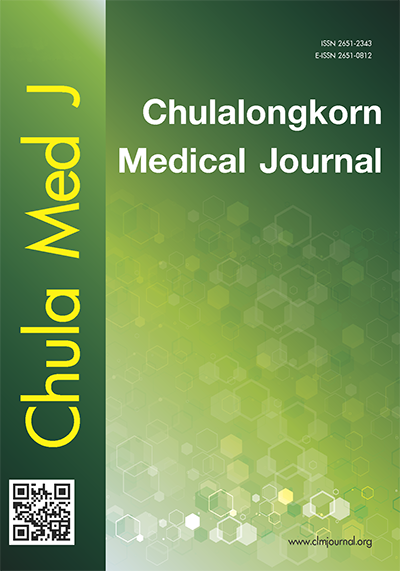MRI differentiation between spinal tumor and spinal infection
Keywords:
Spinal tumor, Spinal infection, MRIAbstract
Background : Although magnetic resonance imaging (MRI) has been the most sensitive and useful investigation in detecting and delineating spinal lesion, spinal tumor and spinal infection may be difficult to be distinguished.
Objective : To find reliable findings to differentiate spinal tumor from spinal infection.
Methods : Four hundred and seventy-nine cases of spinal MRI in 12 months were retrospectively reviewed. Sixty - one cases with MRI diagnosis of spinal tumor or spinal infection were included in the study. Sex, age, location, number of the level of spinal involvement and paravertebral/epidural extension were documented. White blood cell count and percentage of neutrophils were reviewed, if available. Vertebral marrow, disc, paravertebral soft tissue and spinal cord signal intensity (SI) on T1 - and T2 - weighted images, and post gadolinium enhancement were graded.
Results : There were 28 cases of spinal tumor and 24 cases of spinal infection. The significant MRI findings (p - value less than 0.05) between two groups are disc signal on T1 - and T2 - weighted images, disc enhancement, paravertebral soft tissue signal on T1 - weighted images and paravertebral soft tissue enhancement. Paravertebral/epidural abscesses are found only in the spinal infection group. Sacral location is seen only in the spinal tumor group. Age of more than 50 years, multiple levels of involvement and thoracic location are shown in the spinal tumor group more than the infection group.
Conclusion : Decreased disc SI on T1 - weighted images, increased disc SI on T2 - weighted images, disc enhancement, decreased paravertebral soft tissue SI on T1 - weighted images, paravertebral soft tissue enhancement and paravertebral/epidural abscesses are significant findings in spinal infection which is useful in differentiation from spinal tumor. Sacral location is therefore considered spinal tumor. Age of more than 50 years, multiple levels of involvement and thoracic location increase possibility of spinal tumor.
Downloads
Downloads
Published
How to Cite
Issue
Section
License
Copyright (c) 2023 Chulalongkorn Medical Journal

This work is licensed under a Creative Commons Attribution-NonCommercial-NoDerivatives 4.0 International License.










